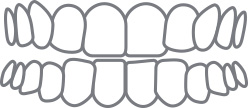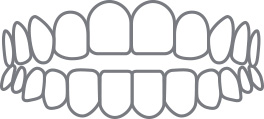Common Orthodontic Issues
Orthodontic treatment relies on appliances, such as braces and Invisalign ®, to align the teeth and jaws. Dr. Scramstad has the knowledge and over 20 years of experience to correct a range of issues. While every patient is different, these are the most common orhodontic cases we see at our Kelowna orthodontic office:

Crowding
When the jaw doesn’t have enough room to accommodate all of the teeth, we call it crowding. In these instances, the teeth typically overlap, get shifted forward or back or twist. What causes crowding? It could be due to the baby teeth falling out too early, an imbalance in the tooth-to-jaw-size ratio or the permanent teeth erupting incorrectly. Since crowded teeth are harder to properly brush and floss, crowding can lead to tooth decay and gum disease.

Spacing
If you have gaps between two or more teeth, it’s known as spacing. Spacing is the opposite of crowding. The issue is often the result of teeth that are too narrow to fill out the jaw, missing teeth or certain oral habits, such as prolonged thumb sucking. A lot of patients are unhappy with how their smile looks when they have spacing, however, it can also have a negative effect on the health of your gums.

Deep bite (Overbite)
A deep overbite is characterized by top teeth that almost completely overlap the bottom teeth. Most people have some degree of an overbite but when the space between the upper and lower teeth is large, it can cause excessive wear, jaw discomfort and make the top teeth more susceptible to injury.

Flared teeth (Overjet)
Overjet refers to teeth that point forward (or flare out) over the bottom teeth. Also sometimes known as protrusion or “buck teeth,” flared teeth are most visible from the side and can make people self-conscious of their appearance. Protrusion can put your teeth at a higher risk of damage and can lead to issues with chewing. Treatment is possible with braces or Invisalign.

Underbite
When your top teeth sit in front of the bottom teeth, you’re said to have an underbite. An underbite can occur if the upper and lower jaws grow at different rates. An underbite may make it difficult to chew and speak properly and leads to uneven wear of the teeth. Since it’s a skeletal issue, it’s extremely helpful if it’s diagnosed and treated at an early age. By using appliances to advance the bottom teeth in childhood, we can often avoid the need for surgery later in life.

Crossbite
If some of the top teeth are inside of the bottom teeth when the jaws are closed together, it’s referred to as a crossbite. A crossbite can either be a front crossbite or a back crossbite. Crossbites are sometimes caused by the early loss of primary teeth, trauma, certain oral habits or genetics. When patients have a crossbite, it’s natural to compensate by shifting the jaw to one side, which can create permanent changes in the facial structure. This is why catching and treating it early can be beneficial.

Open Bite
An open bite is when the top and bottom teeth don’t make contact when you close your mouth. Obviously, this can affect your ability to chew and bite into foods, among other problems. An open bite can be skeletal in nature and the result of genetics or it can be caused by poor oral habits, such as tongue thrusting and prolonged thumb sucking or pacifier use.
Book Your Consultation
Your new smile can begin today! Find out how we make orthodontic treatment work for your lifestyle and needs.
